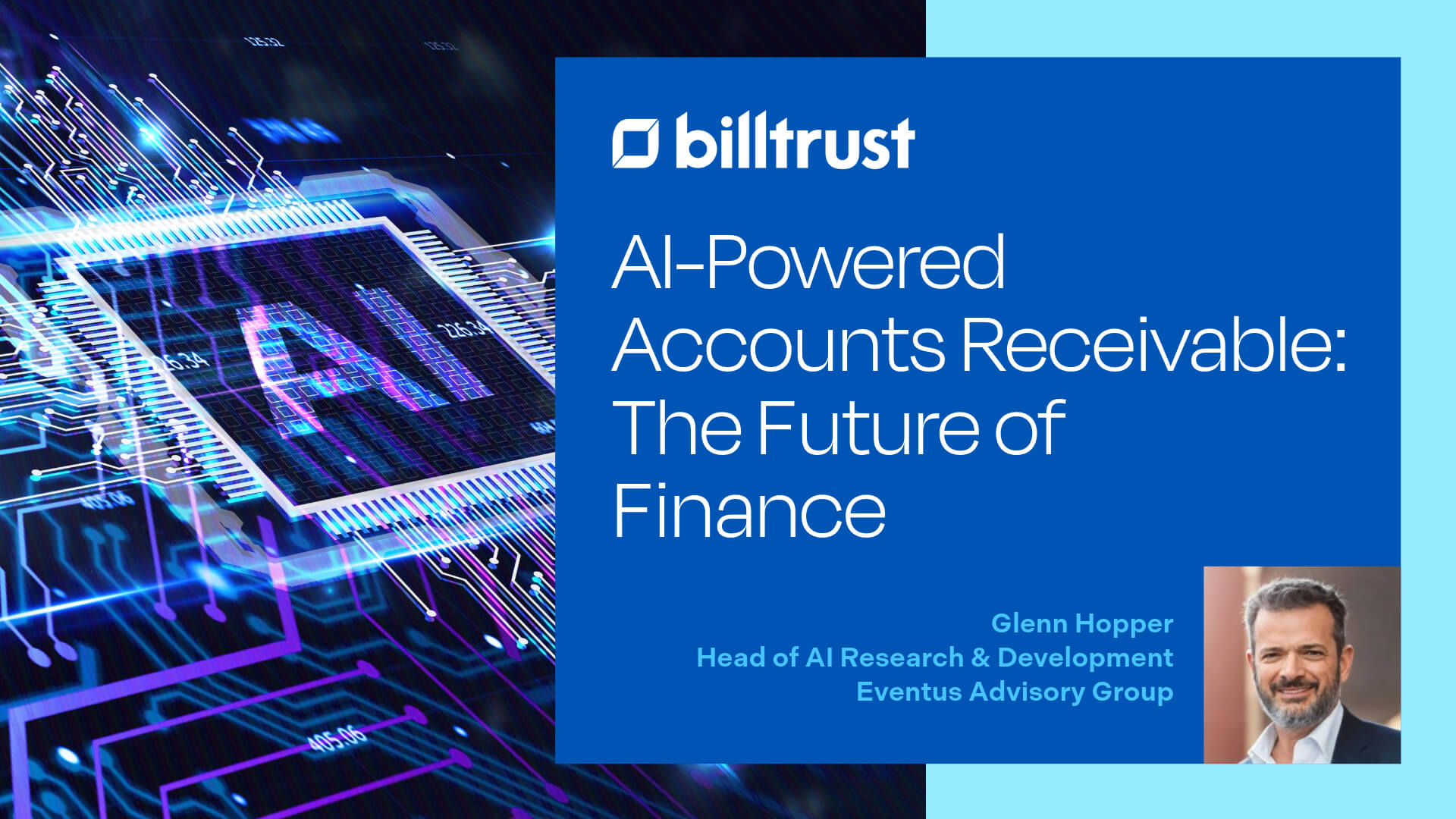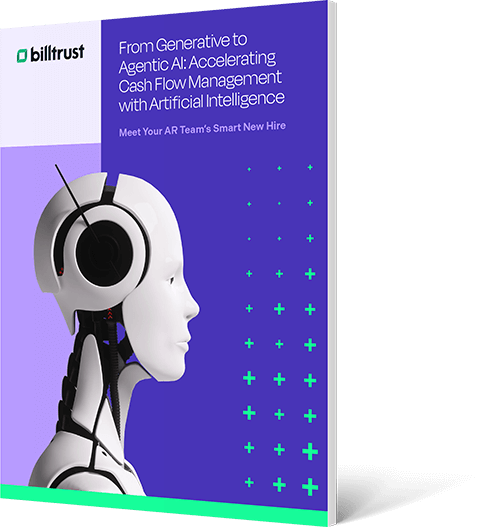Traditional AI analytics and Generative AI are rewriting the playbook for accounts receivable solutions, automating everything from invoicing to collections while unlocking new levels of insight and customer engagement. But how do you separate hype from real-world impact? Moreover, how do you navigate AI adoption while managing risks and ensuring transparency?
Get these answers and more from AI financial expert and author of the book AI Mastery for Finance Professionals, Glenn Hopper. Glenn is the guest speaker in a recent webinar hosted by me, Bob Purcell, CFO at Billtrust. If you missed the event, here’s a quick summary of our discussion and key learnings.

2025: The year of agentic AI
One of the biggest overarching takeaways was this bold statement: 2025 is the year of Agentic AI. “Everyone wants to talk about autonomous agents,” said Glenn, explaining that virtual assistants are becoming more powerful with the ability to act alone. Agentic AI is the newest evolution of AI. Autonomous virtual assistants or “agents” are revolutionizing a host of traditionally manual AR tasks and workflows.
In years past, Glenn received more requests for AI training. This year, however, he is getting more requests for consulting work for AI implementations. “I’m even hearing about more financial bonuses based on AI implementation projects. By 2026, we’re going to see a much higher use of AI across AR,” he said, adding that all the automation capabilities discussed in the webinar are available in the market today.
“AR is an area ripe for AI,” he said. That’s because accounts receivable operations can follow simple rule-based systems – think payment policies and terms or reconciliations that find and match like values. These rules are predefined guardrails that AI systems can easily follow.
But for all the ease of innovation, Glenn also had a clear warning statement about AI.
All automation is not Agentic AI. Vendors want to call every automation tool an agent powered by Agentic AI. But it’s not. To be an agent, the AI model has to be able to reason through a challenge and come up with a solution.
Glenn Hopper, Head of AI Research & Development, Eventus Advisory Group
Learn more in this guide to Agentic AI

AI in AR: challenges and use cases
Our discussion delved into the common challenges faced in traditional AR workflows, such as manual processes, inefficient collections, limited cash flow visibility, and impersonal customer interactions. A quick poll showed that manual processes are the biggest challenge in AR today among attendees.
Glenn explained how AI addresses these issues by automating tasks, optimizing collections, predicting payment timings, and personalizing customer communications.
Manual processes lack visibility. Once you automate them, now you’re knocking down silos and barriers to transparency. Then, data can start flowing.
Glenn Hopper, Head of AI Research & Development, Eventus Advisory Group
AI can then pick up on the patterns and nuances found deep within extensive data sets, performing advanced analysis much faster better than the human brain. “Humans need graphs to understand relationships among data sets, but AI doesn’t,” he added. Now humans don’t have to do the difficult mental work. Instead, they get a list of prioritized actions to take. “The result is predictive and strategic operations.”

We explored detailed examples of AI applications in AR, including:
- Automating Invoicing & Billing: AI streamlines invoice creation and delivery, auto-fills details, flags errors, and matches documents for reconciliation, significantly reducing manual errors and speeding up billing cycles. “One of the best ways to reduce Days Sales Outstanding is to be accurate at the time of invoicing,” explained Glenn.
- AI-Driven Cash Forecasting: Automation enhances cash visibility and AI drives forecasting accuracy, predicting payment timings with over 90% precision and identifying at-risk accounts. “But if you can’t track your data [due to manual tasks], you’re going to miss out on the benefits of AI,” he explained. “Everything AI starts with data, and the system continuously feeds on new data. It’s all dynamic.”
- Customer Segmentation Strategies: AI segments customers based on payment behavior, prioritizes high-risk accounts, and tailors communication channels and tones for improved collections and customer relationships. Common segments are organized based on behaviors (like payment patterns), risk assessments (including payment and credit risk), communication approaches (like channel preferences and the tone to use in collections reminders), as well as priority scoring for high-risk or high-value clients.
- AI in Dispute Resolution: Generative AI automates routine dispute resolution tasks, drafts personalized responses, and enables smart chatbots to handle customer inquiries. AI can perform dispute analysis, response generation, autonomous triage to interpret requests and initiate resolutions, as well as escalate complex cases as needed.
Benefits and considerations for AI adoption
Our discussion also highlighted the benefits of implementing AI in accounts receivable solutions, such as increased efficiency, reduced errors, faster response times, and improved customer experience. Glenn pointed out key considerations for adopting AI, including building trust in AI decision-making, ensuring data quality, integrating with existing systems, and maintaining human oversight.
Intelligent document processing is a key benefit, according to Glenn, adding that Optical Character Recognition (OCR) and machine learning (ML) work together to:
- extract unstructured data accurately across a sea of different formats,
- reconcile information for cash application purposes,
- all while identifying discrepancies for anomaly detection.
“There’s a lot of unsupervised training with ML,” he said, which explains why AI is advancing at faster paces today. Generative AI is equally advantageous. “GenAI is massively efficient. Now you don’t have to worry about performing the right search type – you just ask questions in plain language.”
Efficiency isn’t the only driver of AI. The ROI is not about removing headcount but about making data-driven decisions.
Implementation roadmap for AI-based accounts receivable solutions
To help organizations get started with AI in accounts receivable solutions, Glenn outlined four practical steps for adoption that can help ensure a strong return on investment:
- Prepare Your Data Infrastructure: Clean and unify AR data, establish data governance, and ensure data readiness.
- Choose the Right Technology & Partners: Select AI tools that integrate with existing systems and work with experienced vendors.
- Avoid Common Pitfalls: Start with high impact use cases, take a phased approach, invest in training, and maintain human oversight.
- Continuous Improvement Opportunities: Glenn encouraged continuous improvement and innovation by monitoring AI models, analyzing customer behavior, exploring AI for fraud detection, and optimizing credit policies. “You can have model drift. Just because AI models work today, doesn’t mean they are going to perform accurate predictions on an ongoing basis. AI isn’t set it and forget it,” he said.
AI is not a set it and forget it thing. You have to keep continuously evaluating.
Don’t miss this opportunity to hear from a leading AI expert in the financial industry. Listen to the webinar here.
Staying ahead of the next wave in AI automation
AI is transforming accounts receivable solutions and operations, offering finance professionals practical guidance to drive efficiency, accuracy, and customer satisfaction. But leaders must keep learning to stay ahead of the rapid advances in finance automation. Browse all our webinars for more educational takeaways in AI automation.
FAQ
- Accurate invoicing based on goods or services provided
- Efficient payment collection processes
- Monitoring of customer payment behavior
- Timely follow-up on outstanding invoices


